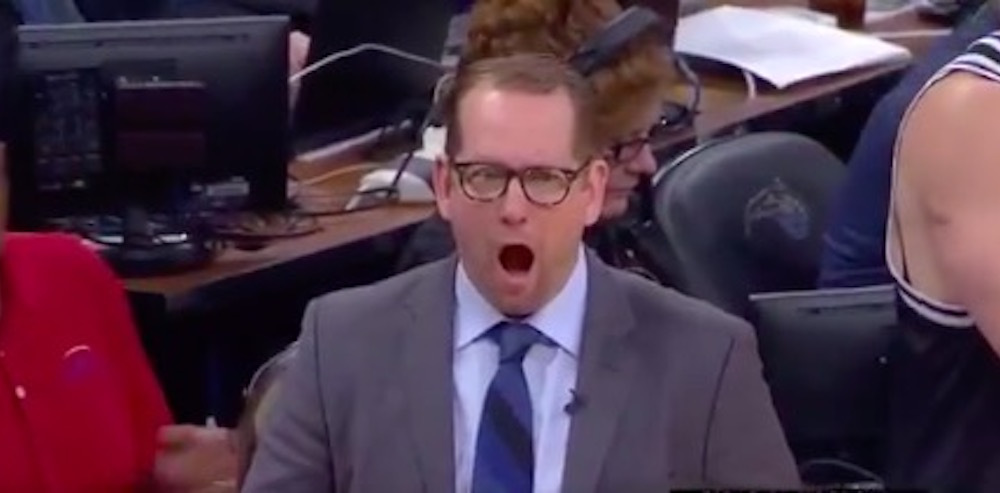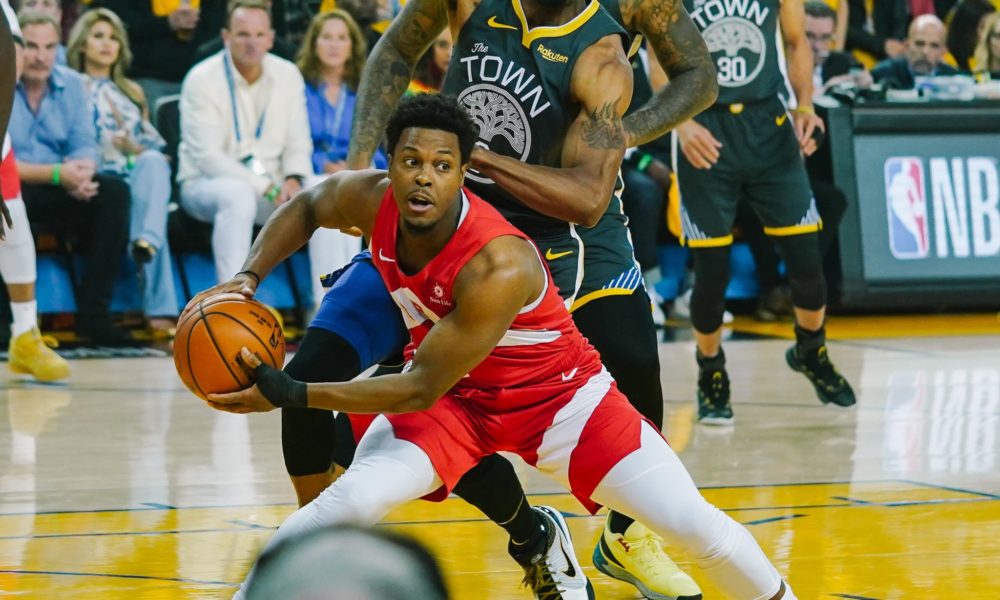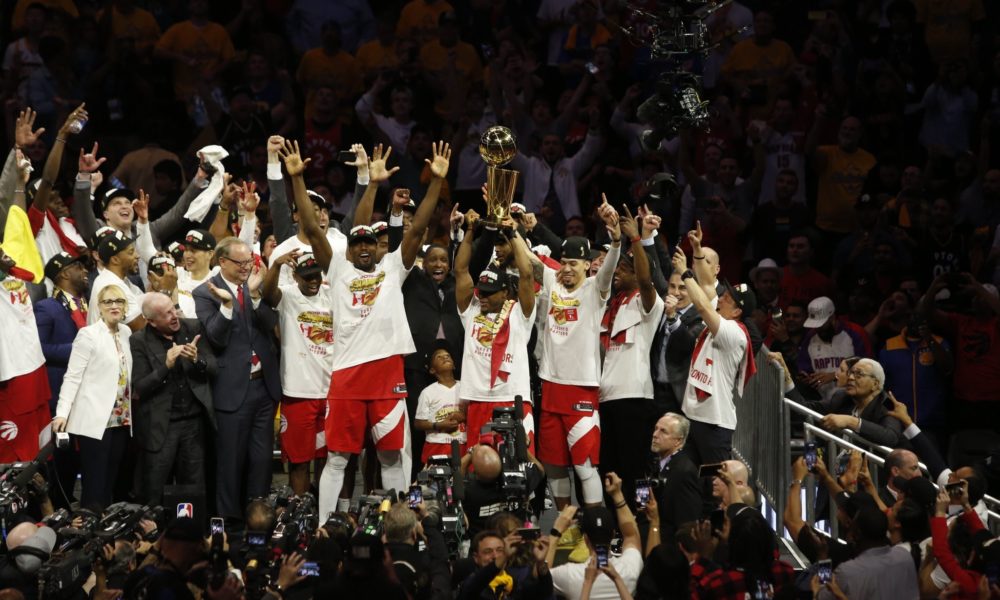In many ways, this series has defied analysis. The Toronto Raptors have outplayed the Golden State Warriors for five straight games, and yet they only lead 3-2. There are positives and negatives implicit in that fact, but that the Raptors have not yet closed the series is concerning. The Warriors possess probably the two greatest shooters of all time, one of whom, Klay Thompson, is as hot as humanly possible thus far in the series. Thompson is scoring 25 a game in this series while shooting 52 percent from the floor and 57 percent from deep. His offense is the single biggest reason the Warriors remain in the series. Letting a team like the Dubs hang around in a series is a recipe for disaster. Still the Raptors have two chances to close out the series and win the title. They’re undefeated in Oracle so far this season, at 3-0, and even if they don’t win, they’ll have another chance at home. The positives vastly outweigh the negatives so far.
Let’s zoom out and look at the big picture of this series so far. The Warriors have shot 38.2 percent from deep so far as a team, which is near the upper limit of an expected outcome. Sure, the Dubs could hit 20 3s again in game six and run away with it; however, my point is that they haven’t lost three games so far because they’ve shot poorly from deep. In fact, they’ve shot quite well from deep and lost anyway. That they outscored Toronto 60-24 from deep in game five and were a Draymond Green miracle block away from losing is a huge positive for Toronto going forward.
The Raptors, on the other hand, have shot 34.1 percent from deep. Again, a reasonable expected outcome, but this time on the low side. The Raptors have been winning games despite shooting relatively poorly from deep. Fred VanVleet (37.9 percent from deep), Kawhi Leonard (37.8), and Danny Green (36.4) have all been shooting about as expected, but Kyle Lowry (32.3) and Pascal Siakam (13.3), especially, have dramatic room for improvement. Lowry has scored well inside the arc, especially in the midrange, but if his deep stroke comes around, it could mean Toronto runs away with game six. Ditto for Siakam – hit a couple from the corner, and laugh all the way to the championship bank.
There are other variables that have gone Toronto’s way, though. The Raptors have attempted 11 more free throws than the Warriors, and they’ve shot nearly 90 percent from the stripe. That’s another area where Toronto has little room to improve. There is, however, room to slip there.
The all-important possession battle has also gone Toronto’s way so far. They’ve taken 13 more shots than the Warriors over the course of four games, which is a necessity as long as Golden State is going to hit more triples. Over the course of five games, Toronto has five more offensive rebounds and 18 fewer turnovers than the Warriors. If those numbers slip at all – say, Leonard fails to grab the 3.0 offensive rebounds per game that he’s snatched so far this series, or Serge Ibaka bobbles a few passes – then Toronto will have a tough time putting enough points on the board. The Raptors need to continue to field more possessions in each game than the Warriors. It’s another area where sustaining their already-high level is critical for Toronto.
Put another way, these are areas in which Toronto is already playing as well as they can. They’re not going to win a game by beating Golden State from the line, or in the possession battle; they’re already doing that. They can lose the game in those areas but probably not win it. On the other hand, if Siakam starts making a few corner 3s, it’s probably time to plan the parade route.
Still, some aspects of the series are too opaque to analyze. Both teams were rattled in the wake of Kevin Durant’s injury, and their play suffered. Despite punting the second and third quarters, Toronto roared ahead in the fourth, and they led by six with three minutes to go. Staff had already begun wrapping the locker room to withstand the champagne showers. Victory seemed guaranteed. And then Toronto’s offense went cold, and the players stopped playing with force. Golden State hit triple after triple. And the Raptors lost. That’s a tough result, and it could be a heartbreaking memory if Toronto wilts in the next few games. But Toronto has been the better team for five straight games, and if that continues, they will surely win this series. Game six is about proving that Toronto’s superiority thus far has been no fluke.
Toronto Depth Chart Updates
PG: Kyle Lowry, Fred VanVleet, Jeremy Lin
SG: Danny Green, Patrick McCaw, Jodie Meeks
SF: Kawhi Leonard, Norman Powell
PF: Pascal Siakam, OG Anunoby
C: Marc Gasol, Serge Ibaka
Golden State Depth Chart Updates
Kevin Durant (achilles) is out. Kevon Looney (collar bone) is playing.
PG: Steph Curry, Quinn Cook
SG: Klay Thompson, Shaun Livingston
SF: Andre Iguodala, Alfonzo McKinnie
PF: Draymond Green, Jonas Jerebko
C: DeMarcus Cousins, Kevon Looney, Andrew Bogut, Jordan Bell
Rotation Notes
- Surprisingly, Toronto’s starters – who continue to have their minutes slashed – continue to win big whenever they’re on the floor. Despite the Warriors dominating the start of game five, the Lowry-Green-Leonard-Siakam-Gasol group won their 13.3 minutes by a ridiculous 12 points. They were excellent at stealing the ball and getting out in transition, and they got a bunch of offense from the line, scoring 10 there.
- Over the course of the series, the starters have averaged 11.3 minutes per game and +2.4 in plus-minus. They’ve been the best group among any that have played in all five games. Only the bizzaro Lowry-VanVleet-Powell-Leonard-Gasol has averaged a higher plus-minus per game (more on them later.) Toronto’s starters have been altogether great, and they’ve had a nice bounce-back series after a difficult showing against the Milwaukee Bucks in the ECF.
- On the other hand, a lineup that was playing well (but had not had great results in terms of plus-minus) actually had quite a poor showing in game five. The starters with VanVleet in Green’s spot lost their 9.5 minutes by eight points. That’s brutal in a one-point loss. In theory, this group allows for simpler defensive matchups, putting VanVleet on Curry, where he has mostly been excellent. That allows Lowry to take a bigger guard or wing, which is his strength. That’s why Nick Nurse has been using VanVleet to start the second half.
- This group actually had some mistakes in game five that limited its effectiveness. VanVleet fouled Curry twice behind the arc, which is one of the most cardinal sins one can commit when playing the Warriors. They didn’t shoot well, and Siakam uncharacteristically hurt the offense with his tentative decisions. I would expect all of those to be one-off problems, and this group should continue to be Toronto’s best going forward.
- With Siakam struggling with his shot and seeming tentative on the catch, Nurse opted to close with Lowry-VanVleet-Powell-Leonard-Gasol. The group doesn’t have a ton of size, but the Warriors are one team against which you can get away with being relatively small in the backcourt and on the wing positions. This unit actually won its few minutes by five points, and it was excellent for a short stretch. Much of that was because Leonard did his usual thing where he turned into the only player on the court for a few minutes at a time. Leonard scored 10 straight points – on a personal 10-2 run – in this lineup, so don’t attribute too much off the success to the other four players on the court. This one was greatly due to Leonard. Nurse, of course, called a timeout with 3:05 remaining, and the group struggled to find any offense thereafter. Even inserting Green for Powell at around the two-minute mark didn’t help the offense much.
- One important takeaway is that Leonard is at his most effective, offensively, as a group’s power forward. That has been true all playoffs. Per Ben Falk’s CTG, the Raptors have scored 0.98 points per half-court play in the playoffs with Leonard at power forward, versus 0.95 when Leonard is at small forward. That distinction is probably why Siakam was on the bench to close the game for the Raptors, although Toronto could have used his defensive length and quickness as the Warriors closed the gap. That’s an easy decision to criticize in hindsight, but there is some information to indicate that when Siakam isn’t playing well, Leonard should be closing at power forward – ie, without Siakam on the floor alongside him.
- Over the series, even though this group has only played in two games, it has outscored the Warriors by eight points. Sure, small sample size and everything, but I wouldn’t be surprised to see this fivesome get a few minutes in game six. It has been playing great on both sides of the ball, and it has the personnel to get out in transition while still keeping the Warriors in the half-court. That’s huge, that is.
- Nick Nurse also said before the game that Siakam didn’t close because he was unhappy with his defensive effort, not because he was missing shots. Siakam’s defense should absolutely bounce back, so I’m confident that he’ll be playing clutch minutes going forward.
Assorted
- Both teams’ stylistic differences have only been ossifying during this series. I wrote in my deep dive preview coming into the series that the Raptors drove the ball far more than the Warriors. That remains true by a ridiculous margin, with the Raptors averaging 51.4 drives per game in the finals, and the Warriors only 27.4. That’s partially because the Warriors lack any real initiators who can attack consistently off the dribble, and partially because the Warriors have a different style of creating offense. Toronto wants to drive into the paint and either finish or kick out for a triple. Golden State wants to pass into the paint for a lob, or if not available, kick out for a triple. The Raptors use more drives, while the Warriors use more off-ball screens and intricate actions. Watching both teams’ weak-sides during any individual action is a study in difference. Toronto has very stagnant weak-sides, trusting that the initial action will create an advantage and force the rotation; weak-side shooters will be forced open by blunt force. Golden State has very active weak-sides, trusting that off-ball screens, slips, and relocations will free shooters even if the initial creator can’t open an advantage on his own. It’s fascinating that two teams in the finals have such different approaches. Neither is inherently better, but they do match both teams’ strengths. Both teams have vastly different strengths, and both coaches have done an excellent job adapting to emphasize their advantages.
- In a sense, the differences in style are contained in the differences between both teams’ best offensive players. Leonard and Siakam do their best work attacking single coverages with the ball. Curry and Thompson do their best work attacking team coverages without the ball. Both teams have evolved their styles to compliment those basic foundations.
- There are a variety of numbers that describe that same difference. Toronto is averaging more seconds per touch (3.1 vs 2.6) and more dribbles per touch (2.3 vs 1.9).
- Let’s talk a little bit more about Klay Thompson’s outrageous performance so far in the finals. He is known as a catch-and-shoot specialist on offense, but he’s been so much more. He can rise up over most defenders due to his quick release, and he’s created excellent for himself off the dribble, too. Thompson is shooting 77.8 percent on pull-up triples so far in the finals, which is unfairly impressive. That dwarfs Leonard’s 47.1 percent (still unfairly amazing) and Curry’s 29.2 percent. Thompson is playing about as well as he ever has.
- Here are the breakdowns for who’s been guarding Thompson and how good of a job they’ve been doing. Note, this data is from nba.com, and it notches a player as Thompson’s primary defender according to amount of time spent during a possession, not who actually ends up defending the shot. So, caveats.

- Leonard has not been excellent guarding either of Thompson or Curry in this series. His greatest on-ball weapon is his strength, and he doesn’t have much of a chance to use it against someone who wants to run around the perimeter and pull up. Neither is much of a driver, so Leonard hasn’t had much of an opportunity to discourage their drives. Leonard is a far more useful defender against Draymond Green or Andre Iguodala. Leonard has been solid at discouraging Thompson from shooting, but he doesn’t stop Thompson from actually, you know, making those shots when they do go up. He is best used elsewhere.
- Danny Green has also been lost several times when guarding Thompson. Even if he makes the most sense on paper, he has not done the best job so far in the series.
- Lowry has done a commendable job on Thompson, and he’s been Toronto’s first option on him. However, Toronto has been sending doubles early whenever Thompson takes Lowry into the post, which forces Toronto to rotate perfectly without the Warriors really doing much on offense. Doubling Thompson in the post has opened up some cracks for shooters, and it’s also opened up the offensive glass. Toronto could just let Thompson take Lowry one-on-one in the post, or…
- I would propose Siakam spend the majority of time on Thompson in this game. He dissuades Thompson from shooting, and he’s excellent at contesting the shot and forcing misses. Siakam is quicker than Leonard, and he’s excellent chasing players around screens. Siakam is longer than Lowry, and he is one of the few who can actually bother Thompson on the release. If he does fall out of position, he’s elite at jumping back into a play to block shots from impossible angles. Using Siakam on Thompson would also free Leonard to guard Green, where he could freelance and switch freely in the pick-and-rolls. Lowry could guard Iguodala, letting Lowry help into the paint and jump passing lanes while also positioning for charges.
- After the KD debacle, a Raptors fan has been raising money through GoFundMe for Durant’s charity. The amount is currently over $20000. Classy move.
- Refs in this one are Marc Davis, David Guthrie, and John Goble.
The Line
- Golden State is -2.5. The over-under is 212.




